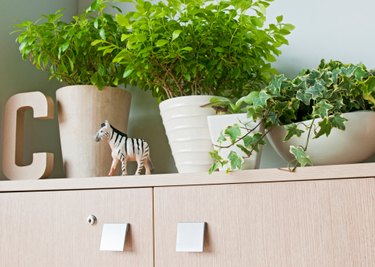Things You'll Need
Stud finder
Pencil
Tape measure
2-by-4 lumber
Hand or circular saw
Deck screws
Drill
Mounting screws
Spackle

Hanging cabinets yourself enables you to save a little money on the cabinet installation. Lower-cabinet installation is pretty straightforward; simply set the cabinets in their intended location and attach them to the wall or floor. Securely mounting upper cabinets onto drywall can be a little tricky. If you don't hang the cabinets properly, the screws will strip the drywall and slide right off the wall, taking your glasses and dishes down with it. A few simple steps will securely attach your cabinets to the walls and prevent broken-dish mishaps.
Step 1
Run a stud finder along the drywall. Lightly mark the location of each stud with a pencil.
Video of the Day
Step 2
Measure from the top of the base cabinet 19½ inches, using a tape measure, and draw a mark the wall. Do this in several locations and connect the marks to create a line around the space to indicate the bottom of your upper cabinet.
Step 3
Cut two-by-four lumber with a hand or circular saw in the same length as the line. Install the lumber so the top of the two-by-four sits on the line. This will support the cabinet as you are installing. Drive deck screws through the ledger board into wall studs to hang the lumber.
Step 4
Mark the spots along the back of the cabinet that will sit flush with a stud. Drill a hole through the cabinet's top hanging rail and bottom hanging rail at these marks.
Step 5
Set the upper cabinet on the wall so the bottom edge is resting on the support lumber.
Step 6
Open the cabinet doors and drive a screw through the drilled holes, through the drywall and into the wall stud. Repeat for all screw holes along the top and bottom hanging rails.
Step 7
Unscrew the support ledge from the wall. Patch the holes in the wall with spackle.
Tip
Once you have found a stud with the stud finder, hammer a nail into the location to verify that you have actually found a wall stud. The stud finder may incorrectly identify plumbing or other hardware as a stud. Once you have found a stud, the next one is usually 16 inches off center.
Video of the Day